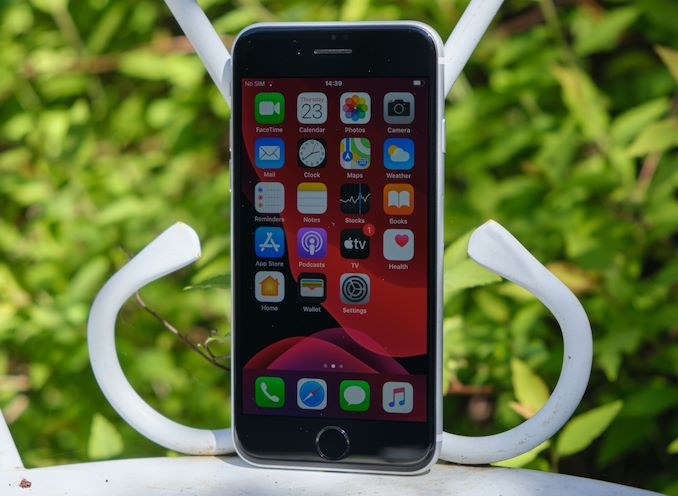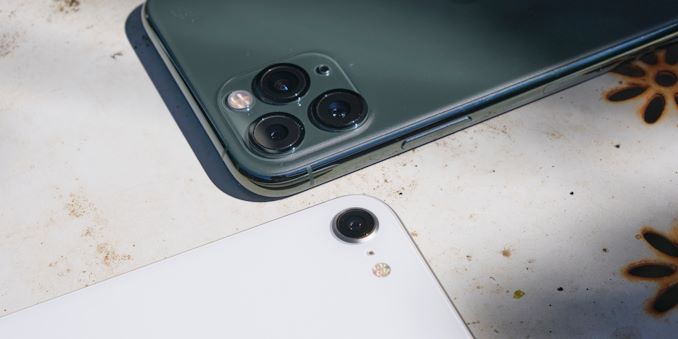The iPhone SE (2020) Review: A Reinvigorated Classic
by Andrei Frumusanu on April 24, 2020 6:30 AM EST- Posted in
- Mobile
- Apple
- Smartphones
- iPhone SE
- Apple A13
- iPhone SE 2020
First Thoughts & End Remarks
This very much has been a light-speed review for a phone that at the time of writing I’ve only received 23 hours ago now, but the iPhone SE is also a phone which many of us should actually be plenty familiar with.
There’s no doubt that Apple's choice of recycling the iPhone 8 design and housing is related to achieving the super low $399 cost of the iPhone SE. This is a manufacturing chain that has been pumping out hundreds of millions of these phones over the years and I imagine that re-using that machinery very much helps the affordability of the phone.
It’s a very familiar design, but it’s certainly no longer a modern one. Besides the actual price of the phone, I can imagine that for some the biggest selling point of the phone is that it’s so a small device compared to other contemporary options. Particularly for people attached to the iPhone and iOS ecosystem, the iPhone SE is the only option going forward if you’re after a small form-factor phone.
The iPhone SE’s display is in line with that of the iPhone 8, meaning it’s an excellent LCD panel with outstandingly good color calibration, although it’s no longer keeping up in terms of brightness and resolution with newer generation OLED phones.
Performance of the iPhone SE is arguably the very best part of the phone, and Apple’s choice to go with the new A13 chipset is an outright disruptive move in the $399 sector. In essence, Apple’s lowest-end phone right now outperforms all other Android flagships on the market, painting quite the stark contrast of the competitive situation of the silicon playing-field.
Camera performance of the iPhone SE was the biggest question mark for the phone, and the new SE delivers on its promises. In daylight pictures, there’s much better HDR and dynamic range characteristics, and Apple here is mostly able to match the compositions of the iPhone 11 in the vast majority of scenarios. Detail-wise, the phone is also extremely strong although slightly lagging behind the class-leading iPhone 11 cameras. Meanwhile colour temperature is still on the warmer side, similar to previous generation iPhones.
Low-light capture, whilst not explicitly tested in this piece today, is significantly improved for the new iPhone SE, massively upgrading the quality of shots compared to the iPhone 8. Whilst it doesn’t quite match the low-light ability of the iPhone 11 series, it’s a very respectable performer here given the lack of computational photography.
Overall, at the end of the day what the new 2020 iPhone SE represents is a $399 iPhone – and that’s a selling point all by itself. It’s a significantly better device than the now discontinued iPhone 8, for a cheaper price. You’re getting the best performance of any mobile device out there on the market – and the compromises in the screen, battery life and cameras are reasonable given the price of the phone.












196 Comments
View All Comments
ingwe - Friday, April 24, 2020 - link
Very impressed overall. Glad Apple finally released something at this price range again. Time to upgrade from my SE.haukionkannel - Friday, April 24, 2020 - link
I agree, very impressive indeed! This makes most other middle range phones look really bad in comparison!linuxgeex - Friday, April 24, 2020 - link
Hopefully Sandcastle will get to a point where we can install Android 11 on this and end up with a phone we can actually customise and install the software of our choice on vs the limited Apple ecosystem. And I'd love to see whether the Geekbench numbers hold up when running on Android, so we can see whether/how much Apple has been cheating on that benchmark ;-)mrochester - Saturday, April 25, 2020 - link
Why would you want to ruin an iPhone by putting android on it? The whole reason the iPhone is so popular is because it’s NOT android!Oxford Guy - Saturday, April 25, 2020 - link
The last time I tried Android it was so bad I returned the phone.But, iOS is seriously annoying in some ways — like how it spams you with random pop-ups telling you that you can turn on location tracking.
Well, if you choose "Ok" to dismiss the pop-up it turns on location tracking. The only other option you're given is "Open Settings". How many conventions does the pop-up violate?
1) Totally modal? Check.
2) No way to close the window without choosing from bad options? Check.
3) Comes up without any prompting/relevance? Check.
4) Behaves in a way that's user-hostile? Check
5) Behaves in multiple ways that are user-hostile? Check.
6) Violates expected UI conventions ("Ok" to dismiss)? Check.
Of course, one should expect that location tracking is still enabled even if it's "off".
One of the things I always find amusing is how my car always knows I have an iPhone because it's broadcasting Bluetooth even when Bluetooth is "turned off".
Oxford Guy - Saturday, April 25, 2020 - link
7) Gives you two laborious options instead of a simple/efficient option? Check.8) Makes it seem like one option is laborious but the other is simple (deception)? Check.
yeeeeman - Saturday, April 25, 2020 - link
Last time you probably tried android was version 2.0. Now we're at version 10. Try it again.Oxford Guy - Sunday, April 26, 2020 - link
"Last time you probably tried android was version 2.0. Now we're at version 10. Try it again."I tried it before I purchased an iPhone 8.
(Given JCheng's comment, Apple may have changed the behavior of the pop-up between iOS 12 and the most recent, which I believe is 13. I am still using 12 for the moment, despite Apple's harassment over that which is another topic.)
RSAUser - Sunday, April 26, 2020 - link
Android 7? That's quite a while ago, missing a lot of newer things, I'm on 10 currently.Android 8 introduced:
- Project Treble (updates are way faster now due to modularization, I get an update every month)
- Adaptive icons (theming, circle, square, rounded, etc.)
- Notification improvements (channels (grouping), badges, snooze, multi-colors)
- System-wide autofill
- Can limit app background activity and location checks
- Color management for display
- 8.1 onward: Neural networks API, sahred memory API, Bluetooth battery level for connected devices, auto light and dark themes
Android 9:
- Screenshot option to lock menu
- Lockdown mode
- Notifications are "rich", can include images, smart replies, etc.
- Volume slider change (the two bars, that can also pop out to be all media controls without having to go to all the settings)
- Pill gesture system (I kind of still prefer this to the Android 10 gestures, a bit torn)
- "Shush", mute standard notifications if phone is face down
- Adaptive battery (way better hibernation, my phone lasts me two days easy with 7/8 hours screen on)
- Auto brightness based on habits (I think I adjust brightness maybe once a month or so, usually if watching a super dark video)
Android 10:
- New permissions system for once off only, only if shown, etc
- Background apps can't jump to foreground
- AV1 codec support (Netflix uses way less data and space.)
- System-wide dark theme
- New gesture navigation
- Project Mainline: Core OS components updated via google play store, no more restart for those updates or reliant on manufacturer and carrier to approve.
I'm still wondering what Android 11 will bring, since Android 10 is really well fleshed out now, the next couple of updates will be minor things, same for iOS. Only recently used iOS again since ~10, 13 is actually pretty nice, just a little annoyed by how difficult it is to easily connect to specific BT devices, Android still has better pop-up imho, though really happy iOS finally introduced it.
Best thing would have been if iOS left both old and new gestures in, with toggle options for which you want, ah well.
flyingpants265 - Friday, May 8, 2020 - link
I mean.. almost everything in that list is crap.-Keyboard still lags when popping up, when it should be the fastest feature on the entire phone. It's about 5x slower than it should be (I measured against other UI movements)
-App-switching is laggy on every phone.
-App-switcher (Recents) is still UNORDERED EVERY SINGLE TIME, no options to configure this. Each iteration of Recent apps is worse.
-Most of the software takes up way more memory/CPU than it should.
-Most of the apps have very bad UI, lots of clicking through menus and going "back" with the wonky back button, it's truly an adventure.
-Multi-window is useless. We've had widgets for 10+ years (also useless), but nobody thought to put widgets inside multi-window so you can do multiple things from the same screen.
-Can't do basic things like switch between different multi-window panes that are already set up (app1+app2 to app3+app4). Think "multi desktop".
-Can't do basic things like configure swiping left/right between different apps, i.e, I'm in Discord, I swipe left to go to WhatsApp. I swipe right to go to Skype. When I first heard about/saw Android, I saw the "swiping screens around" thing and I was blown away. Turns out, all you can do is swipe between your fucking multiple home screens.
-The battery usage window has EVEN FEWER details, it's actually gotten worse over time, so I can't even really see where 8AM is in the graph.
-Still no way to manually re-order/sticky your notifications in the list, therefore, you'll never develop muscle memory for the notification list.
Doing a simple task like finding an image online, downloading it, cropping it, uploading it to imgur, getting the link, and sharing it to a friend.. takes a full minute, when using Gyazo on a PC takes 6 seconds. I have timed it. On the Android phone, most of the time, you are waiting for lag.. apps to switch, features to load.. then clicking through awful UIs. Somehow, nobody ever thought to just make the software work properly? What happened? Everything worked fine on my Pentium 3. Even Atom can do multi-window, multi-tasking, with full windows apps (not crippled Android apps). Seriously, what happened? Did we all just forget how to write computer programs?
I am usually refuted by saying "Oh yeah, well MY device isn't bad.. MY device isn't slow..." That's because you are not using it properly. Try doing multiple things very quickly, and you will be slowed down by the bad UI/apps/OS, even on the latest flagship phones.
I know what the problem is. People are just content to use what they've got, instead of thinking carefully, and creating a vision of how an ideal phone OS "should" work. It's a form of collective brainwashing, and lack of initiative/creativity. It's really that simple. Fix all these problems first, and make the phones unbreakable/easily repairable, and finally THEN, maybe we can talk about paying $999 for a phone.
iOS is even worse.